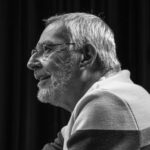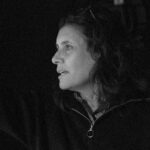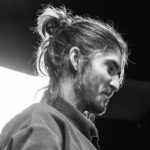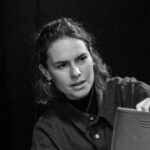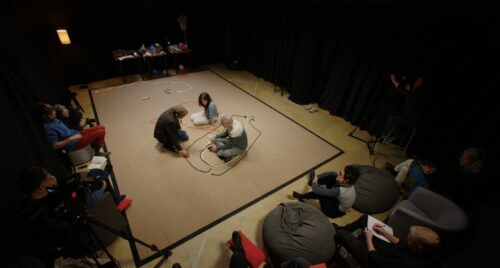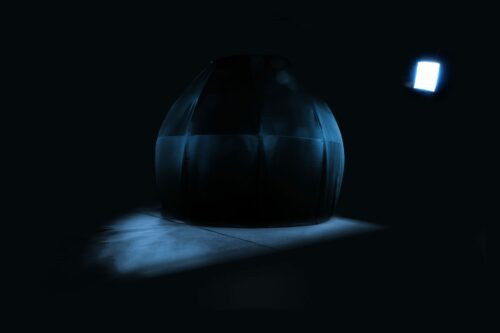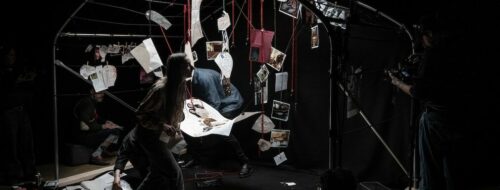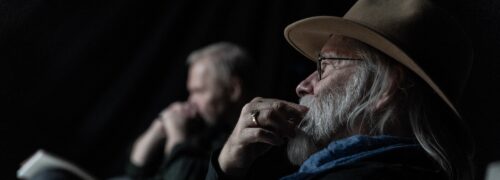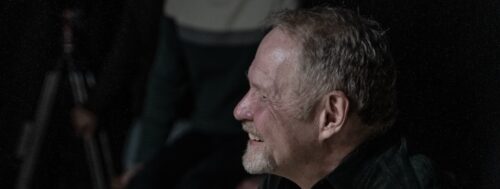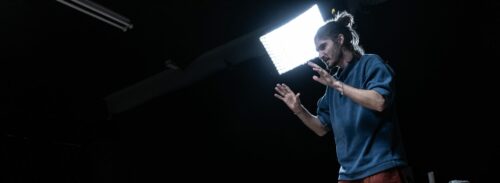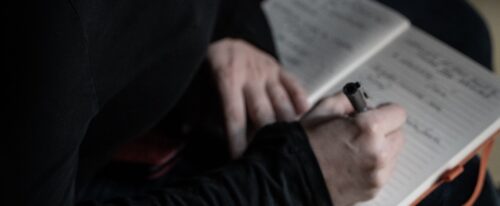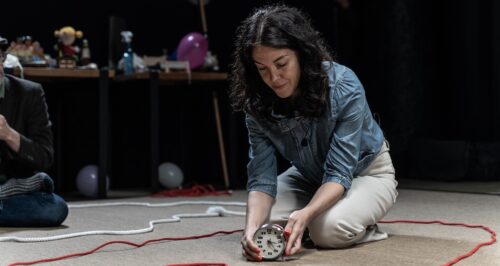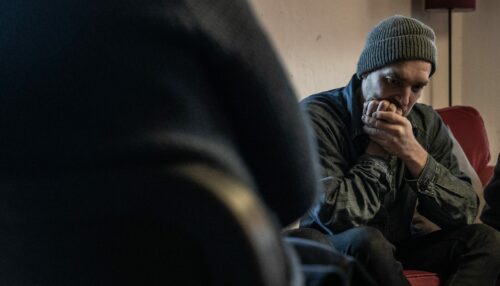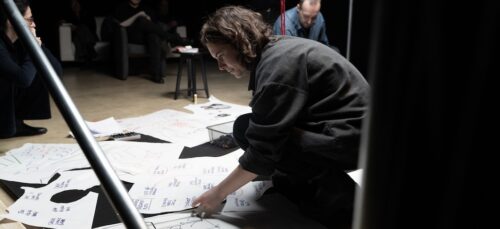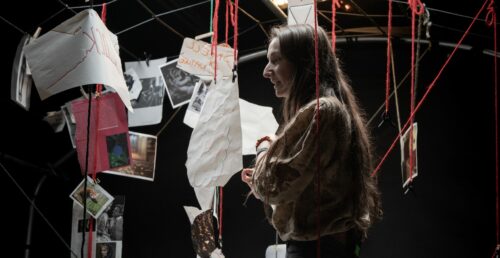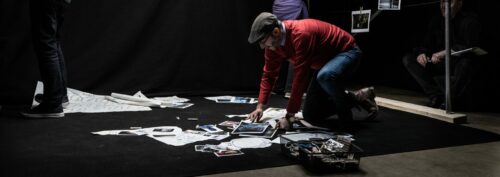2. The Black Room
The Black Room stems from a very simple starting point: how do the ideas and components of a story develop without sight and without the body moving through space ?
In this experimental space, we inject sounds of different kinds, interior/intimate sounds, sounds from the outside world, one after the other, trying to generate impacts and a flow of possibilities according to the nature of each project.
The result turns out to be the starting point for a new field of possibilities for storytellers. A renowned anthropologist, a specialist in the earliest manifestations of stories in caves, explained to us that our exploration led us to the origins of shamanism as a source of narrative flow…
— As part of its 5th season, the StoryTANK team wanted to try a new experiment, under the guidance of six passionate and captivating researchers. The goal was to test and film the emergence of story ideas within experimental frameworks created by LA FABRIQUE DES MONDES — a unique initiative in Europe, developed at Le Groupe Ouest since 2023, under the auspices of the French Ministry of Culture.
The experience was offered to six screenwriters or filmmakers from six different European countries. Here, the StoryTANK provides an opportunity to explore and shed light on the creative process.
Below, a debrief by screenwriter and researchers, as he reflect on there experience.
REVEALING THE UNKNOWN WORLDS OF THE STORY
“The Black Room is like a Native American sweat lodge: you forget everything superfluous.”
The Black Room is a place that reveals. In Native American culture, sweat lodges are built: you enter a completely dark teepee with embers heating the stones, making you sweat, but in a good way. You don’t feel any pain from the heat; you feel like a lot of things are being expelled from you and immersing you in worlds you don’t know. The Black Room takes us into inner, shared worlds that even the author doesn’t know, which we discover by entering it: an extraordinary experience. In the Black Room, we are forced to be with ourselves and the people we encounter. We forget the superficial, the superfluous. The Black Room opens up immense possibilities. – Marcel Beaulieu

THE LOSS OF REFERENCE POINTS IN DARKNESS TO SEEK THE LIGHT OF THE STORY
“The Black Room is a short circuit between reality and unconsciousness”
With the darkness of the Black Room, we are forced to seek the light of something. We don’t know what. We are forced to illuminate ourselves from within, and the character, lost in a no man’s land, is forced to say to himself: yes, I have two legs, I have two arms, I have a head. But what is inside us? The Black Room is a short circuit between reality and unconsciousness. Suddenly, something is happening, because we no longer have any reference points. The Black Room forces you to enter into what you are and into your own impossibilities and all the perspectives that can arise. You’re confronted with yourself, and then, wow, that’s great! An author has to confront that! – Marcel Beaulieu

THE WARMTH OF OTHERNESS TO CREATE THE NARRATIVE
“The Black Room is emotional”
The Black Room is emotional. The fact of not seeing, of being immersed in darkness, of being surrounded by others whom you don’t see, but whom you feel: they breathe, they think—the feelings are there. This warmth, which you feel in the darkness, you don’t need a thermal camera to sense and see it. It is fascinating, both mentally and physically. – Massimiliano Nardulli
SILENCES TO STIMULATE THE STORY
“Silences express more than a thousand words”
Massimiliano Nardulli – In the Black Room, sometimes just breathing or a small movement from one of the co-authors to the right or left makes you feel part of something, something much stronger and much deeper than just seeing it. Silences, more than words, have an incredibly powerful force. Sometimes, silences express more than a thousand words and allow the Black Room to engage and stimulate us greatly, physically and mentally. It’s a double moment of communication, I would say: a communication with your inner self—the darkness you have within you that must emerge—and a communication with others and for the story being composed.
THE QUEST FOR THE GENESIS OF A STORY
“Giving Birth to a Possible Voice for a Character”
The Black Room is a device that can be used in a very personal way, while connected to others, for inner research on a character and to give birth to a possible voice for that character, thus truly bringing it to life, seeking it out in the depths of one’s own mind. Experiencing the Camera Obscura, alone or with others, allows for transcendence, to search in intimate and buried corners for what can nourish a character, a situation, the story, in its entirety. – Massimiliano Nardulli
SUBMERSION BY EMOTION FOR THE PROJECTION OF THE STORY
“In the Black Room, we find the characters!”
In the Black Room, we find the characters. Sound and emotion allow for an organic search, particularly in the identification of characters, through the imagination of what we project onto the sounds we hear. We inevitably project people, sounds, either in the first person or because we imagine a character. There’s a kind of letting go possible when we’re in the dark. It’s a place where the body is there, but as if at rest: we can forget it and let the mind or emotion emerge. The Black Room works at the heart of our unconscious, investigating the more animal, organic, and profound components of the story that are within us. Violette Garcia
A PROTOCOL, A SPECIFIC QUEST TO OPEN THE STORY
“The Black Room puts us in a state of meditation, of trance, a kind of altered state that drives us a little crazy.”
I suddenly enter the Black Room and, in a second, I’m curled up, touching my forehead in a regressive, fetal movement, like a big, strange baby. It’s a little strange, but it’s a good way to be both completely within myself and, at the same time, to fully feel the others around me. The experience is very intense because it’s “agitated.” Starting with the protocol that leads us to know what we’re looking for there precisely, the Black Room plunges us into a state of meditation, of trance, a kind of altered state that drives us a little crazy. – Violette Garcia

NOURISHING THE COMPOSITION OF THE STORY THROUGH SOUND
“Experimenting with sound, through the creation of a free and exploratory soundtrack, allows us to come together and connect.”
With the Chambre Noire, experimenting with sound, through the creation of a free and spontaneous soundtrack, allows us to come together and connect. A collective sonic imprint at a specific moment in the composition of the story that allows us to delve deeper, quite subliminally. – Violette Garcia
INTIMATE AND SHARED LISTENING TO THE POTENTIAL OF THE STORY
“In the Black Room, we have a character in mind and we become that character, precisely”
In the Black Room, the experience is more intimate. Thanks to attentive listening in the dark, the mind is overwhelmed by emotion and wanders, as part of a conscious reflection on the potential of the story. We have a character in mind and we become that character, precisely. We feel the same strength emanating from our co-authors with whom we began the experience, from the Grotto. We are both under collective control and, in a state of trust, fully experiencing this state of creation. – Violette Garcia
THE STORY, AT THE CENTER
“The Black Room, like when we were children: telling each other ghost stories”
The Black Room is not a Black Room like in the film industry—a large square set with black walls—but rather a place where we can sit, lie down. There is a center, and we are around it. It’s like being with Sami shamans in their igloo in Norway, with drums, or like when we were children: telling each other ghost stories. – Raitis Ābele
WATCHING A NARRATIVE IN COMPOSITION, THROUGH SOUND
“The Black Room to move to another mode of perception where images are produced, not by our eyes, but in depth”
We first listened to sounds we had chosen at random, before connecting them to the narrative we were generating. Listening in the dark requires adapting to this darkness, to move to another mode of perception where images are produced not by our eyes, but in depth. After spending more time in the dark, we are surprised by what we see; it’s a bit like a psychedelic journey where images arrive on their own, and all we can and must do is look. The less we feel our bodies, the more images appear and emotions arise. – Raitis Ābele
NARRATIVE AS EMOTIONAL TEXTURE
“In the Black Room, the characters’ feelings became a quest”
In the Black Room, unlike the Cave (which is very visual), the sole use of sound makes it entirely sensory. Sitting in a circle in the Black Room provokes a rather primitive physical sensation, as if we were sitting around an imaginary fire together. We lose our sense of self, unable to see anything, and we allow ourselves to be invaded solely by the sound: feeling it more than hearing it. It’s both terrifying and incredible, because suddenly, these sounds create an emotional texture, based on associations with the characters and the ideas germinated in the Cave. Suddenly, the Black Room allows for a heightened imagination. And the characters’ feelings become a quest: sadness and pain become intense, for example, and were not present in the Cave. – Isla Badenoch
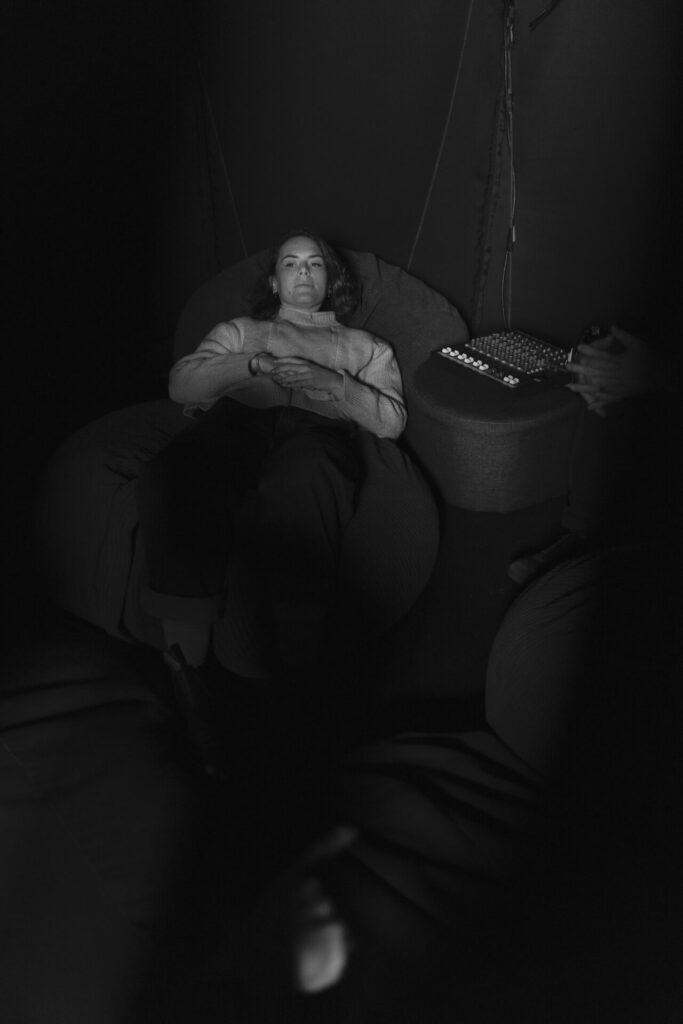
STORYTELLING, AN INDIVIDUAL EXPLORATION WHITIN THE COLLECTIVE
“The Black Room reminded me of a collective dream, in which we are all connected, while each living our own experience.”
In the Black Room, in complete darkness, lying down: we react not to what we see, but only to what we imagine. Like a collective dream, we are connected, while each responding to stimuli in our own way, and we then listen to the experience lived by others, while having lived our own experience. Very close to the experience of trance, the Black Room is similar to that of cinema in the sense that all the articulated moments are not only brought about by the narration, nor even by a character, but simply captivating, without necessarily any explanation. When we are standing, we are in a position of preparation and performance. When you enter the Black Room, you can lie down, while being in a very active state, you then react precisely to sounds, data and ideas and, display precise sequences of scenes or incarnations. You extract yourself from your bodies to be able to become someone else and slip into the skin of a character. Then, by listening to the feelings of others, on the connected set of fragments of shared visions. Sharing was really important and, in a way, it helped us to leave the device. The moment we turn on the light again, the exit is smooth. I don’t think I’ve ever had such a liberating experience in my creative development work. It’s really profound. – Gabrielle Brady
FREEZING TIME TO MOVE THE STORY FORWARD
“In the Black Room, time no longer has any effect”
As they enter the Black Room, I share aloud: “They’re like speleologists entering a place where time no longer exists, and reappearing as if it were twenty years later.” Time no longer has any effect because it stops, freezes. – Théo Gorin
COMBINING INDIVIDUAL AND COLLABORATIVE STORYTELLING EXPERIENCES
“The Black Room provides security and intimacy for unfolding the story”
The Black Room provides security and intimacy: two very important elements for storytelling. When you feel in a safe environment: where there is no threat, where you can express yourself, where there is less judgment, without outside scrutiny. There is also the darkness and finally the posture. We sit, a little slumped, very comfortable, arms or legs outstretched, even though the space is relatively small. Others had their knees almost under their chins, a slightly tense attitude. A very individual storytelling experience, unlike the group game, for the Plateau, an experience of collaborative storytelling. Samira Bourgeois-Bougrine
PLAYING WITH THE BRAIN TO STIMULATE STORY COMBINATIONS
“We need moments when we block out visual information because it’s disruptive and doesn’t allow us to access our deepest memory, our feelings.”
We need moments when we block out visual information because it’s disruptive and doesn’t allow us to access our deepest memory, our feelings. In the brain, we have a control center that looks outward and inward, meaning it will direct our attention toward something that scares us, for example, a dangerous animal. Or, for example, in a safe environment, it will direct it inward. And so, when we close our eyes or when we’re in the dark, this control center is somewhat muted, somewhat turned off. We then access deep memory, and new things emerge, directing us towards interesting combinations to compose the story, to simulate them mentally. – Samira Bourgeois-Bougrine

ABSTRACTION AS THE IMPETUS FOR STORYTELLING
“When we’re in the dark and we have this feeling of security, we process information holistically: we see the forest and not the trees.”
The feeling of security felt in the Black Room is one of the triggers of what we call holistic processing. To simplify: concrete processing is when we look at a tree, and holistic processing is when we look at the forest. So, when we’re in the dark and we have this feeling of security, we process information holistically. And when information processing is holistic, we think abstractly. – Samira Bourgeois-Bougrine

